What is RERA Act an How to Register for It?

Welcome to our comprehensive guide on the Real Estate Regulation and Development Act, 2016, more commonly known as RERA. The Act was implemented on 1st May, 2016, with 61 out of 92 parts being officially announced. The remaining clauses were implemented on 1st May, 2017.
In this blog, we'll delve deep into RERA so you know exactly what it means and why it's important for developers and property purchasers alike. We'll walk you through the key procedures for registering with RERA, demonstrate how to verify a property's registration status, clarify the distinctions between real carpet area and RERA carpet area, and discuss other important aspects of the act. Let’s get started!
What Does "RERA Approved" Mean?
"RERA Approved" signifies that a property complies with all the stipulations of the Real Estate (Regulation and Development) Act, 2016, ensuring credibility and security in real estate transactions. Here’s what this means for both developers and buyers:
For Developers:
- Legal Compliance: Achieving RERA approval means the project meets all regulatory requirements, which is a legal necessity.
- Market Advantage: RERA approval boosts the developer’s reputation by demonstrating transparency and adherence to strict standards, making the
- project more attractive to potential buyers.
- Trust and Credibility: It reassures investors and buyers of the developer's commitment to delivering the project as per the plans approved by the authorities.
For Buyers:
- Enhanced Security: A RERA-approved project gives buyers confidence in the legality and compliance of the property, reducing investment risks.
- Transparency: Buyers have access to all critical information about the project, ensuring that they are fully informed about their investment.
- Financial Safety: The act mandates that 70% of the funds collected from buyers be kept in a separate bank account, used solely for construction, preventing financial mismanagement.
- Grievance Redressal: Buyers have the right to seek redressal from the RERA tribunal if there are any issues or disputes with the project, providing a strong safety net.
How to do RERA Registration?
Registering a real estate project under RERA is a crucial step for developers, ensuring compliance and enabling transparency. Here’s a detailed step-by-step guide on how to go through the RERA registration process, followed by the documents required.
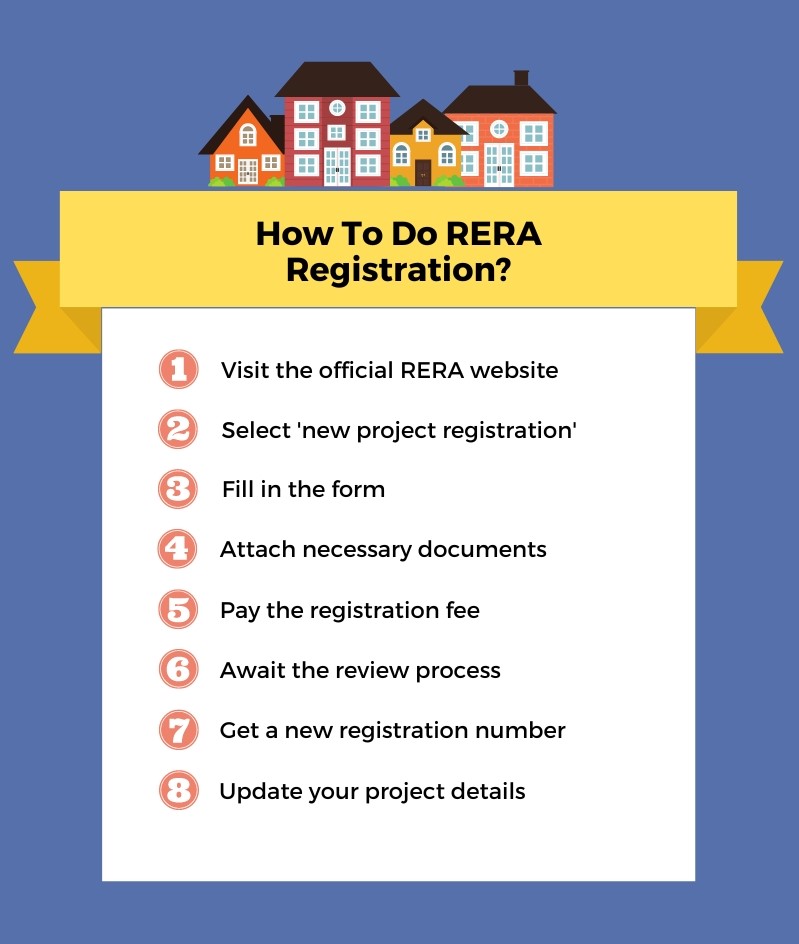
Step-by-Step Guide on the Registration Process for Developers
- Visit the Official RERA Portal: Each state has its own RERA portal. Developers must access their respective state's portal designed for RERA registration.
- Create an Account: Developers need to create an account by providing necessary details like name, contact information, and email address, which will be used for all future communications.
- Fill in the Application Form: Complete the application form available online. This includes detailed information about the developer, the project, and its legal status.
- Upload Required Documents: As part of the application, upload all the necessary documents (listed below). These documents must be certified by a practicing Chartered Accountant, a practicing Architect, and a practicing Engineer.
- Pay the Registration Fee: A non-refundable registration fee, which varies from state to state, must be paid online during the submission of the application.
- Verification Process: Once submitted, the RERA authority will examine the application and documents. This process can take up to 30 days.
- Grant of Registration: If the application is in order, the RERA authority will grant a registration number, certificate, and a login ID to the developer, which must be quoted in all sales and promotions.
Required Documents and Prerequisites
Here is a list of the common documents that developers need to furnish for RERA registration:
- Legal Title Deed: Proof of the legal title of the property, including rights to the land.
- Encumbrance Certificate: Current status regarding any encumbrances on the property.
- Development Plan: Detailed plan of the project, including layouts, location details, and floor plans.
- Approval and Commencement Certificate: From the respective municipal corporation or authority.
- Architect's Certificate: Regarding the design and the external infrastructure of the project.
- Engineer’s and CA’s Certificate: Certifying the project's estimated cost, construction standards, and the financial management plan.
- PAN Card and Aadhaar Card: For identity and address verification.
- Previous Work Details: Detailed information about past projects completed by the developer in the last five years.
How to Check RERA Registration Status of a Property?
Verifying the RERA registration status of a property is a very important step for buyers to ensure the legitimacy and compliance of their potential investment. Here's how you can check the RERA registration status online:
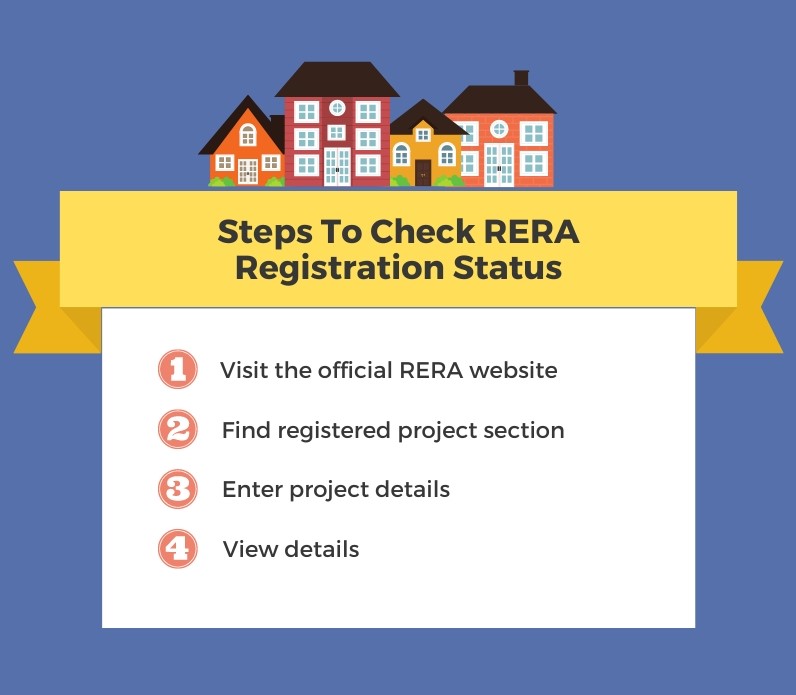
Detailed Guide on Checking Registration Status Online
- Identify the Appropriate RERA Website: Each state in India has its own RERA portal. Determine the portal associated with the state where the property is located.
- Navigate to the RERA Portal: Access the official RERA website for the respective state. These portals are typically straightforward to navigate and are designed to be user-friendly.
- Find the Property Search Option: Look for an option like ‘Project Details,’ ‘Project Status,’ or ‘Check Project Registration.’ This section is dedicated to searching for and viewing registered projects.
- Enter Required Details: You may need to enter details such as the project name, developer name, or registration number. Some portals might also allow searches by location or developer’s PAN number.
- View the Project Details: After submitting the search query, the portal will display details of the project if it is registered. This includes the RERA registration number, project status, builder details, and other relevant information.
- Verify the Information: Ensure all details, like project timelines, approved plans, and financial details (like bank account numbers where the project funds are secured), align with what was promised by the developer.
Importance of Verifying RERA Status for Buyers
- Legality and Compliance: Checking the RERA status confirms that the project complies with the regulatory standards set by the government, ensuring it is legally sound.
- Transparency of Information: RERA portals provide comprehensive details about the project, including approvals, land title status, and track record of the developer. This transparency helps buyers make informed decisions.
- Protection Against Fraud: Verifying RERA registration helps protect against fraudulent schemes and ensures that the project has met all the necessary prerequisites before it is marketed.
- Confidence in Investment: Knowing that a project is RERA registered increases buyer confidence as it guarantees oversight from RERA authorities and adherence to commitments made by the developer.
Key Differences between RERA Carpet Area and Actual Carpet Area
Understanding the distinction between RERA carpet area and the actual carpet area is crucial for buyers, as it influences both the valuation of the property and the actual living space available. Here’s a detailed look at these concepts:
RERA Carpet Area vs. Actual Carpet Area
| RERA Carpet Area | Actual Carpet Area |
|---|---|
| According to RERA, the carpet area is defined as the net usable floor area within an apartment, excluding the area covered by the external walls, areas under services shafts, exclusive balcony or verandah area, and exclusive open terrace area, but includes the area covered by the internal partition walls of the apartment. | Actual carpet area refers to the area of the apartment that excludes the thickness of the internal walls. It is often used by developers in marketing materials prior to RERA, and may not always include details about exclusions, leading to confusion among buyers. |
Examples and How Differences Can Affect Buyers
- Example of Calculation Differences: Suppose a flat is advertised with an actual carpet area of 1000 square feet (excluding internal walls). Under RERA, the carpet area might only be 950 square feet when accounting for the internal walls and other exclusions defined by RERA.
- Impact on Pricing: If a developer charges per square foot, the difference in carpet area definitions can significantly impact the total cost. For instance, a price of ₹5,000 per square foot would mean a difference of ₹250,000 between the RERA carpet area and the actual carpet area as advertised before RERA.
- Expectations vs. Reality: Buyers might visit a show flat designed based on the actual carpet area (without internal walls) and feel satisfied with the space. However, when the property is handed over with the RERA carpet area calculation, it might seem smaller due to the inclusion of internal walls and other factors. This can lead to dissatisfaction and disputes.
For detailed guide about carpet area, built up area, super built up area, RERA carpet area you can read our blogs: 1. Built Up Area and Carpet Area 2. Built-up Area vs. Super Built-up Area.
Dealing with Disputes and Complaints under RERA
The Real Estate (Regulation and Development) Act, 2016, establishes a clear and efficient framework for addressing disputes and complaints related to real estate projects, ensuring that both buyers and developers have a platform to resolve issues. Here’s how grievances are handled under RERA:
Process for Filing Complaints Under RERA
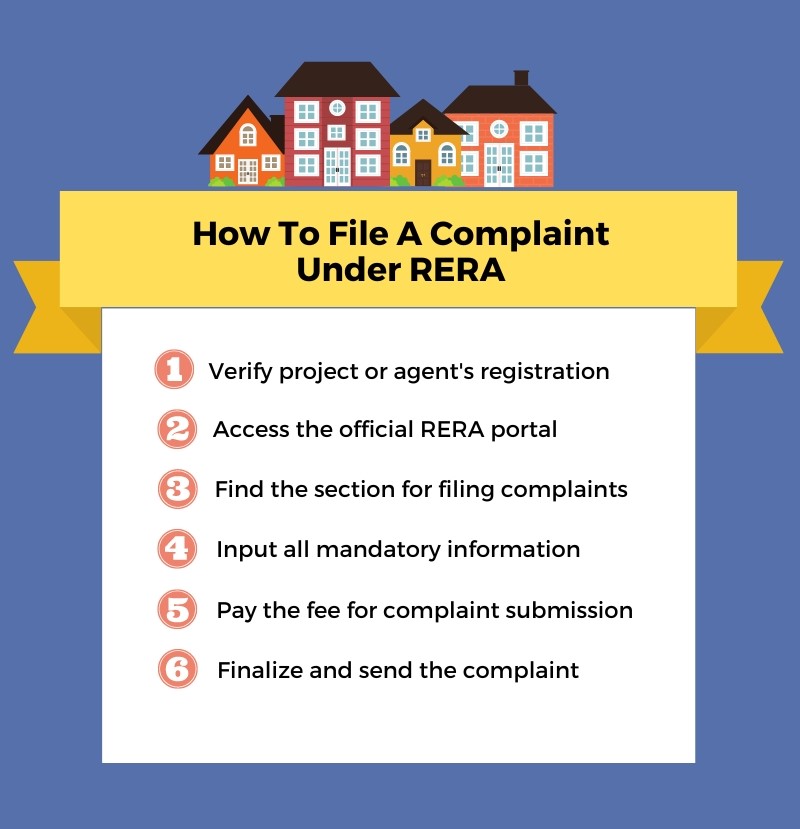
- Determine Eligibility for Filing a Complaint: Any aggrieved party, including buyers, developers, or real estate agents, can file a complaint under RERA for any violations of the act.
- Submission of Complaint: Complaints can be filed online through the official RERA website of the respective state, or at the office of the RERA authority. The complaint must detail the grievance and include relevant documentation to support the claims.
- Payment of Fees: A nominal fee is required to file a complaint, which can be paid online or at the RERA office during the submission of the complaint.
- Review and Hearing: Once a complaint is filed, it is reviewed by the RERA authority. If the complaint meets the criteria, a date is set for a hearing. Both parties are called to present their case before the RERA adjudicating officer.
Mechanism for Dispute Resolution
- Adjudication by RERA Authority: The RERA adjudicating officer, appointed specifically for dispute resolution, hears the cases. The officer is equipped to handle legal issues under RERA and has the authority to enforce decisions.
- Interim Relief: If required, the RERA authority can provide interim relief to the aggrieved party until the final decision is made, ensuring that no irreversible damage is done during the period of dispute resolution.
- Final Decision and Enforcement: After hearing from both parties, the RERA authority makes a decision based on the facts and evidence presented. The decision is legally binding and enforceable. If either party is dissatisfied with the decision, they can appeal to the Appellate Tribunal.
- Appellate Tribunal: The Tribunal is the second level of judicial scrutiny under RERA where appeals against the decisions of the RERA authority can be filed. Decisions made by the Tribunal can further be appealed in the High Court, subject to the conditions of the appeal.
Applicable Penalties under RERA
RERA outlines strict penalties for non-compliance and violations to ensure that developers adhere to the rules and regulations aimed at protecting home buyers. Here are the key violations and corresponding penalties under RERA, and how the act enforces compliance.
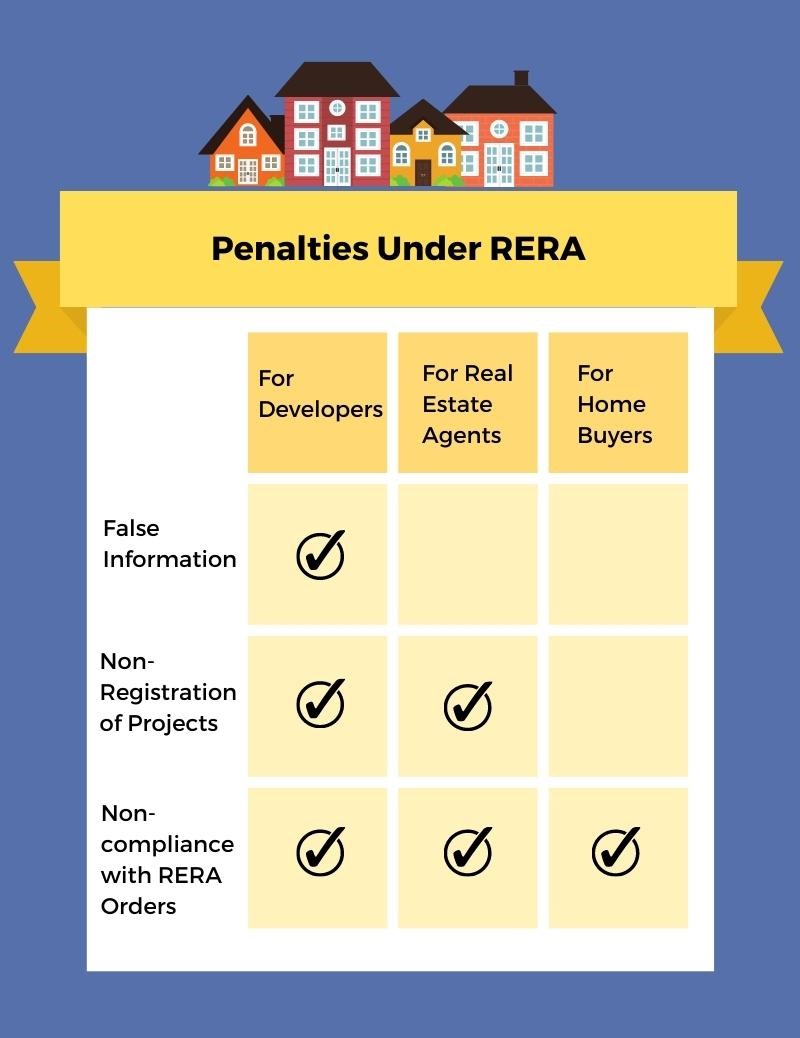
List of Violations and Corresponding Penalties for Developers
- Non-Registration of Projects: Developers failing to register their project with RERA face a penalty of up to 10% of the project’s estimated cost. Repeated non-compliance could lead to imprisonment for up to three years, or an additional fine of 10% of the estimated project cost, or both.
- False Information or Violation of Laws: Providing false information during the registration process or breaching any provisions of the Act can attract a penalty of 5% of the estimated cost of the project.
- Diversion of Funds: If a developer is found to divert funds collected for a specific project to other uses, it could result in a penalty of up to 5% of the project’s cost, and severe cases might lead to imprisonment.
- Delay in Handover: For delays in project completion and handover, developers are required to pay an interest rate of 2% above the State Bank of India’s Marginal Cost of Lending Rate (MCLR) to the buyers for the period of the delay.
- Non-compliance with Regulatory Orders: Failure to comply with the orders of the RERA authority or appellate tribunal can result in additional penalties, including imprisonment for up to one year, a fine that may extend up to 10% of the project’s estimated cost, or both.
How RERA Enforces Compliance
- Rigorous Monitoring: RERA authorities conduct regular audits and checks on ongoing projects to ensure compliance with the registration and financial management norms as stipulated by the act.
- Mandatory Quarterly Updates: Developers are required to submit quarterly updates regarding the progress of registered projects, which are monitored by the RERA authority. Non-compliance with this requirement can lead to penalties.
- Escrow Account Auditing: To prevent the diversion of funds, RERA mandates that 70% of the funds received from buyers be deposited in an escrow account. These accounts are subject to regular audits by professionals appointed by the RERA authority.
- Grievance Redressal Mechanism: RERA has established a robust grievance redressal mechanism which allows buyers to file complaints directly with the RERA authority. This ensures that any violations by developers are quickly addressed and penalized.
- Transparency and Public Access: All information submitted by developers is made publicly accessible through the RERA website. This transparency ensures that deviations and violations are easily detectable by authorities and the public, enhancing overall compliance.
Understanding the Benefits Offered by RERA
RERA has significantly transformed the real estate landscape in India. Here, we explore the benefits it offers to homeowners and investors, as well as its long-term impacts on the real estate market.
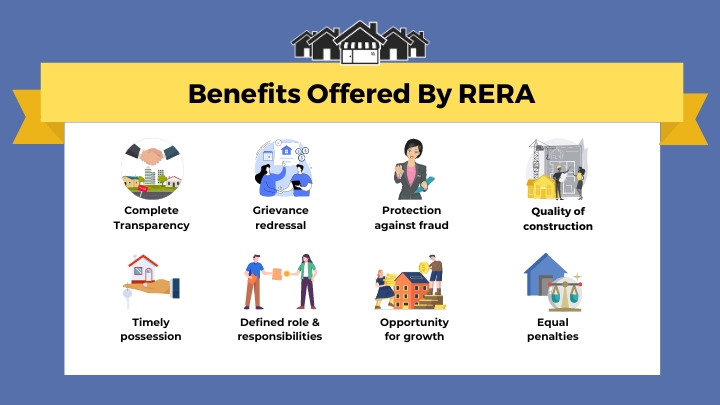
Benefits for Homeowners and Investors
- Enhanced Transparency: RERA mandates that all registered projects disclose detailed information regarding the project plans, status, and legalities on the RERA website. This transparency helps homeowners and investors make informed decisions.
- Improved Accountability: Developers are held accountable for any delays or deviations from promised project deliverables. RERA ensures that developers adhere to the promised timelines or pay penalties, thus safeguarding buyer investments.
- Financial Security: The requirement to deposit 70% of the funds collected from buyers into an escrow account ensures that funds are used only for the designated project, reducing the risk of fund mismanagement.
- Standardization of Sale Agreements: RERA introduces a standardized model of sale agreements which prevents unfair practices and ensures clarity and fairness in real estate transactions.
- Grievance Redressal Mechanism: Homeowners and investors have access to a dedicated grievance redressal system, which allows for quick resolution of disputes related to real estate projects.
- Quality Assurance: With stricter regulations on project approvals and certifications, buyers are more likely to receive properties that meet all stated quality and safety standards.
Long-term Impacts on the Real Estate Market
- Increased Market Confidence: The introduction of RERA has restored confidence among buyers and investors in the real estate market, evidenced by more structured investments and a steady demand for compliant properties.
- Boost to Investment: The transparency and security provided by RERA encourage not just domestic but also international investors to consider the Indian real estate market as a viable investment destination.
- Regulation of Pricing: With increased transparency and reduced risk of project delays, there is likely to be a more rational and stable pricing mechanism in the real estate market.
- Promotion of Professionalism: The act compels developers and agents to adopt professional and ethical business practices, which in turn enhances the overall reputation of the real estate sector.
- Sustainable Development: RERA encourages developers to undertake sustainable and environmentally friendly practices in project development, aligning with global standards for real estate.
Embrace RERA for Transparent and Reliable Real Estate Transactions
Throughout this comprehensive exploration of RERA, 2016, we have uncovered the essential facets of RERA, from its registration processes and the importance of verifying a property's RERA status, to the nuances of carpet area definitions and the significant protections it offers to both developers and property buyers. We've delved into the stringent penalties for non-compliance and highlighted the robust dispute resolution mechanisms that ensure fairness and transparency within the industry. These reforms have not only protected the interests of home buyers but have also helped establish a more structured and reliable market environment for developers and investors.
Let us all strive to uphold the standards set by RERA and utilize this regulatory framework to achieve a more organized, reliable, and prosperous real estate market. Remember, a well-informed approach to real estate is not just a benefit but a necessity in today's market landscape. Engage with RERA, stay informed, and secure your real estate transactions with confidence.
FAQs
What Happens If Builder Does Not Follow the RERA Order?
If a builder does not follow a RERA order, RERA authorities have the power to impose penalties or take other actions. In extreme cases, the authority can even revoke the registration of the project. The builder may also face imprisonment for non-compliance with the orders of the RERA tribunal.
How to Check RERA Registered Projects and Find RERA-Approved Projects
Buyers can check RERA registered projects on the official RERA website of their respective states. The websites have a 'Registered Projects' section where you can enter the unique RERA registration number of the project for verification.
Is RERA-approved property safe?
A RERA-approved or RERA-registered property implies that the project has met the criteria set by the Real Estate (Regulation and Development) Act, 2016. It means that the developer has provided all necessary disclosures and is in compliance with the regulatory requirements, which include maintaining 70% of the funds collected from buyers in a separate escrow account to be used only for the construction of the project, among others.
While RERA registration increases the credibility of a project and provides a safety net for buyers, it does not completely eliminate all risks associated with real estate investments. Buyers should still perform due diligence, like verifying the developer's track record, checking the legal status of the land, and inspecting the quality of construction, among others.
Is RERA applicable all over India?
Yes, the Real Estate (Regulation and Development) Act, 2016 (RERA) is a central act that applies to all states and Union Territories in India. However, the implementation of the act is not uniform across the country. As land and land improvement is a subject on the State List under the Indian Constitution, the RERA Act allows each state and Union Territory to set up its own regulatory authority and formulate rules according to the local requirements while following the central framework of the Act.
What are the RERA rules for parking allotment?
According to RERA, the parking area is considered a common area, and hence it cannot be sold separately. It is included in the cost of the flat or unit that the buyer purchases. The builder cannot charge an additional amount for the parking space. Each buyer has the right to parking space, and the builder cannot deny this.
What are the RERA rules for redevelopment projects?
Redevelopment projects where new units are created also come under the purview of RERA. Builders must register these redevelopment projects with RERA and comply with all other rules of the Act, including maintaining 70% of funds in a separate account, providing all necessary details of the project, and ensuring the project's timely completion. The protection and rights provided by RERA to buyers also apply to those who are part of a redevelopment project.
How RERA will help buyers?
RERA has brought in several provisions aimed at protecting the interests of homebuyers:
- Transparency: Developers are required to disclose detailed information about their projects, including the layout plan, timeline, status of statutory approvals, etc.
- Accountability: Developers are required to park 70% of all project funds into a dedicated account. These funds can only be used for construction and land costs, which curbs the common practice of diverting funds to new projects.
- Standardization: RERA mandates the sale of properties based on carpet area, which is the area within the walls of the apartment. This prevents malpractices where builders sold properties based on super built-up area.
- Grievance Redressal: RERA establishes a real estate regulatory authority and an appellate tribunal in every state, where aggrieved buyers can file complaints against developers. These bodies are required to dispose of complaints within 60 days.
- Fair Play: RERA imposes strict regulations to ensure accountability and fairness in the practices of real estate agents as well.
- Compensation: RERA provides for compensation to buyers in case of delays in project completion. If the buyer wants to withdraw from a project, they are entitled to a full refund along with interest.










